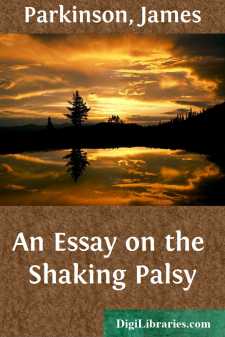Categories
- Antiques & Collectibles 13
- Architecture 36
- Art 48
- Bibles 22
- Biography & Autobiography 813
- Body, Mind & Spirit 142
- Business & Economics 28
- Children's Books 15
- Children's Fiction 12
- Computers 4
- Cooking 94
- Crafts & Hobbies 4
- Drama 346
- Education 46
- Family & Relationships 57
- Fiction 11829
- Games 19
- Gardening 17
- Health & Fitness 34
- History 1377
- House & Home 1
- Humor 147
- Juvenile Fiction 1873
- Juvenile Nonfiction 202
- Language Arts & Disciplines 88
- Law 16
- Literary Collections 686
- Literary Criticism 179
- Mathematics 13
- Medical 41
- Music 40
- Nature 179
- Non-Classifiable 1768
- Performing Arts 7
- Periodicals 1453
- Philosophy 64
- Photography 2
- Poetry 896
- Political Science 203
- Psychology 42
- Reference 154
- Religion 513
- Science 126
- Self-Help 84
- Social Science 81
- Sports & Recreation 34
- Study Aids 3
- Technology & Engineering 59
- Transportation 23
- Travel 463
- True Crime 29
An Essay on the Shaking Palsy
by: James Parkinson
Categories:
Description:
Excerpt
CHAPTER I.
DEFINITION—HISTORY—ILLUSTRATIVE CASES.
SHAKING PALSY. (Paralysis Agitans.)
Involuntary tremulous motion, with lessened muscular power, in parts not in action and even when supported; with a propensity to bend the trunk forwards, and to pass from a walking to a running pace: the senses and intellects being uninjured.
The term Shaking Palsy has been vaguely employed by medical writers in general. By some it has been used to designate ordinary cases of Palsy, in which some slight tremblings have occurred; whilst by others it has been applied to certain anomalous affections, not belonging to Palsy.
The shaking of the limbs belonging to this disease was particularly noticed, as will be seen when treating of the symptoms, by Galen, who marked its peculiar character by an appropriate term. The same symptom, it will also be seen, was accurately treated of by Sylvius de la Boë. Juncker also seems to have referred to this symptom: having divided tremor into active and passive, he says of the latter, “ad affectus semiparalyticos pertinent; de qualibus hic agimus, quique tremores paralytoidei vocantur.” Tremor has been adopted, as a genus, by almost every nosologist; but always unmarked, in their several definitions, by such characters as would embrace this disease. The celebrated Cullen, with his accustomed accuracy observes, “Tremorem, utpote semper symptomaticum, in numerum generum recipere nollem; species autem a Sauvagesio recensitas, prout mihi vel astheniæ vel paralysios, vel convulsionis symptomata esse videntur, his subjungam.” Tremor can indeed only be considered as a symptom, although several species of it must be admitted. In the present instance, the agitation produced by the peculiar species of tremor, which here occurs, is chosen to furnish the epithet by which this species of Palsy, may be distinguished.
HISTORY.
So slight and nearly imperceptible are the first inroads of this malady, and so extremely slow is its progress, that it rarely happens, that the patient can form any recollection of the precise period of its commencement. The first symptoms perceived are, a slight sense of weakness, with a proneness to trembling in some particular part; sometimes in the head, but most commonly in one of the hands and arms. These symptoms gradually increase in the part first affected; and at an uncertain period, but seldom in less than twelvemonths or more, the morbid influence is felt in some other part. Thus assuming one of the hands and arms to be first attacked, the other, at this period becomes similarly affected. After a few more months the patient is found to be less strict than usual in preserving an upright posture: this being most observable whilst walking, but sometimes whilst sitting or standing. Sometime after the appearance of this symptom, and during its slow increase, one of the legs is discovered slightly to tremble, and is also found to suffer fatigue sooner than the leg of the other side: and in a few months this limb becomes agitated by similar tremblings, and suffers a similar loss of power....


